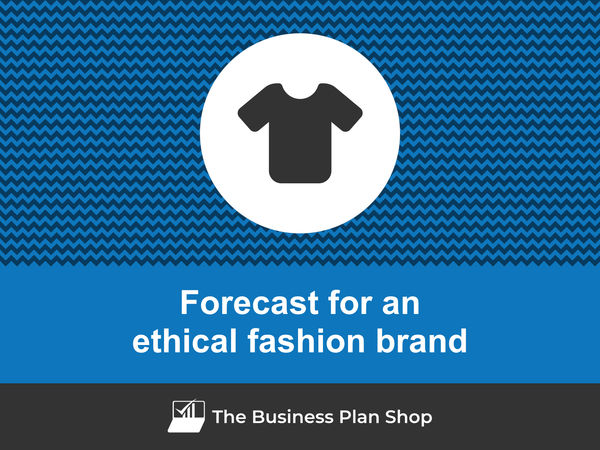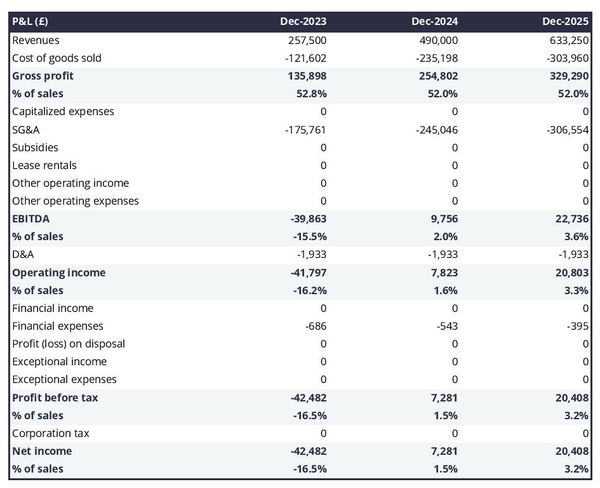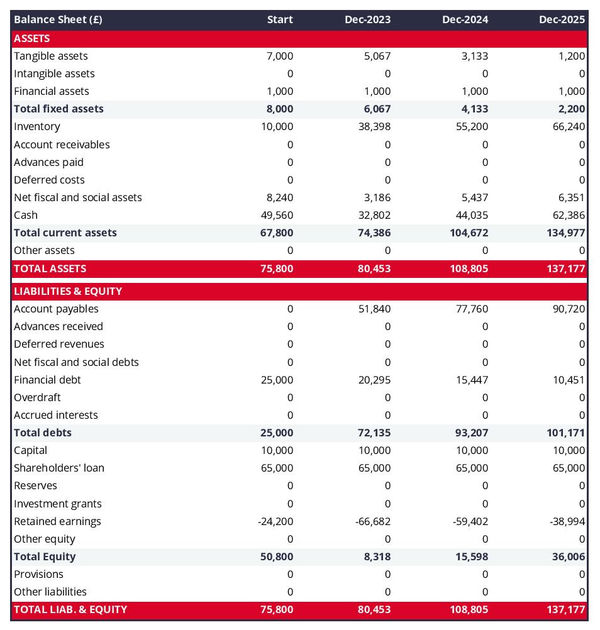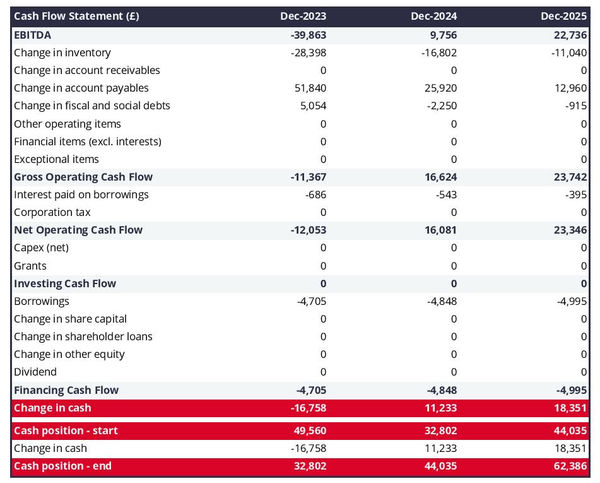How to create a financial forecast for an ethical fashion brand?

Developing and maintaining an up-to-date financial forecast for your ethical fashion brand is key in order to maintain visibility on your business’s future cash flows.
If you feel overwhelmed at the thought of putting together an ethical fashion brand financial forecast then don’t worry as this guide is here to help you.
We'll cover everything from: the main objectives of a financial forecast, the data you need to gather before starting, to the tables that compose it, and the tools that will help you create and maintain your forecast efficiently.
Let's get started!
Why create and maintain a financial forecast for an ethical fashion brand?
Creating and maintaining an up-to-date financial forecast is the only way to steer the development of your ethical fashion brand and ensure that it can be financially viable in the years to come.
A financial plan for an ethical fashion brand enables you to look at your business in detail - from income to operating costs and investments - to evaluate its expected profitability and future cash flows.
This gives you the visibility needed to plan future investments and expansion with confidence.
And, when your trading environment gets tougher, having an up to date ethical fashion brand forecast enables you to detect potential upcoming financing shortfalls in advance, enabling you to make adjustments or secure financing before you run out of cash.
It’s also important to remember that your ethical fashion brand's financial forecast will be essential when looking for financing. You can be 100% certain that banks and investors will ask to see your numbers, so make sure they’re set out accurately and attractively.
Need a solid financial forecast?
The Business Plan Shop does the maths for you. Simply enter your revenues, costs and investments. Click save and our online tool builds a three-way forecast for you instantly.

What information is used as input to build an ethical fashion brand financial forecast?
A ethical fashion brand's financial forecast needs to be built on the right foundation: your assumptions.
The data required to create your assumptions will depend on whether you are a new or existing ethical fashion brand.
If you are creating (or updating) the forecast of an existing ethical fashion brand, then your main inputs will be historical accounting data and operating metrics, and your team’s view on what to expect for the next three to five years.
If you are building financial projections for a new ethical fashion brand startup, you will need to rely on market research to form your go-to-market strategy and derive your sales forecast.
For a new venture, you will also need an itemised list of resources needed for the ethical fashion brand to operate, along with a list of equipment required to launch the venture (more on that below).
Now that you understand what is needed, let’s have a look at what elements will make up your ethical fashion brand's financial forecast.
The sales forecast for an ethical fashion brand
The sales forecast, also called topline projection, is normally where you will start when building your ethical fashion brand financial forecast.
Creating a coherent sales projection boils down to estimating two key drivers:
- The average price
- The number of monthly transactions
To do this, you will need to rely on historical data (for an existing business), market research data (for both new and existing ethical fashion brands), and consider the elements below:
- Shift towards sustainable fashion: With increased awareness and demand for ethical and sustainable fashion, customers are willing to pay a higher average price for products that align with their values. This can lead to an increase in your average price per transaction.
- Competition from fast fashion brands: Fast fashion brands often offer lower prices and frequent sales, making it challenging for ethical fashion brands to compete. This could lead to a decrease in your average price per transaction.
- Economic downturn: During an economic downturn, consumers may be less willing to pay a higher price for ethical fashion items. This could result in a decrease in your average price per transaction.
- Celebrity endorsements: Celebrity endorsements and collaborations with ethical fashion brands can increase brand visibility and credibility, leading to an increase in your number of monthly transactions.
- Innovative designs and materials: Offering unique and innovative designs, as well as using sustainable and eco-friendly materials, can attract customers and differentiate your brand from competitors, potentially leading to an increase in your average price per transaction.
After the sales forecast comes the operating expenses budget, which we will now look into in more detail.
Need inspiration for your business plan?
The Business Plan Shop has dozens of business plan templates that you can use to get a clear idea of what a complete business plan looks like.

The operating expenses for an ethical fashion brand
The next step is to estimate the expenses needed to run your ethical fashion brand on a day-to-day basis.
These will vary based on the level of sales expected, and the location and size of your business.
But your ethical fashion brand's operating expenses should include the following items at a minimum:
- Staff costs: This includes salaries, benefits, and training for all employees, including designers, production workers, and sales staff. You may also need to budget for hiring temporary workers during busy seasons.
- Accountancy fees: As an ethical fashion brand, you may need to work with an accountant who specializes in sustainable and ethical business practices. This can include preparing tax returns, managing finances, and providing strategic financial advice.
- Insurance costs: In addition to standard business insurance, you may also need to budget for specialized insurance to cover any ethical or sustainable practices, such as fair trade certification or organic materials.
- Software licenses: To manage your inventory, sales, and marketing, you will likely need to invest in software licenses for programs such as inventory management, point-of-sale systems, and marketing automation.
- Banking fees: Your bank may charge fees for services such as wire transfers, international transactions, and merchant services. Consider finding a bank that offers lower fees for ethical and sustainable businesses.
- Raw materials: As an ethical fashion brand, you will likely be sourcing sustainable and ethically-produced materials. These may come at a higher cost than traditional materials, so be sure to budget accordingly.
- Production costs: This includes all costs associated with manufacturing your products, such as labor, equipment, and facilities. Ethical production may also include additional costs for fair wages and safe working conditions.
- Marketing and advertising: To promote your brand and products, you will need to budget for marketing and advertising expenses such as social media ads, influencer partnerships, and print materials.
- Packaging and shipping: As an ethical fashion brand, you will likely want to use sustainable and eco-friendly packaging materials. These may come at a higher cost, so be sure to budget accordingly. You may also need to factor in shipping costs for both raw materials and finished products.
- Rent and utilities: If you have a physical retail store or office space, you will need to budget for rent and utilities. Consider looking for eco-friendly and energy-efficient options to align with your brand values.
- Travel expenses: You may need to travel for sourcing materials, attending trade shows, or meeting with suppliers. Be sure to budget for transportation, lodging, and meals.
- Professional fees: This includes fees for services such as legal counsel, graphic design, and web development. As an ethical fashion brand, you may also need to budget for consulting fees for sustainability and ethical practices.
- Research and development: To stay ahead in the fashion industry, you will need to invest in research and development for new designs and materials. This can include costs for prototyping, testing, and materials.
- Taxes and duties: As a business, you will need to pay taxes and duties on your products. If you are sourcing materials or manufacturing in other countries, be sure to budget for any additional fees or tariffs.
- Charitable donations: As an ethical fashion brand, you may want to give back to organizations or causes that align with your values. Be sure to budget for charitable donations as a part of your operating expenses.
This list is, of course, not exhaustive, and you'll have to adapt it according to your precise business model and size. A small ethical fashion brand might not have the same level of expenditure as a larger one, for example.
What investments are needed to start or grow an ethical fashion brand?
Your ethical fashion brand financial forecast will also need to include the capital expenditures (aka investments in plain English) and initial working capital items required for the creation or development of your business.
For an ethical fashion brand, these could include:
- Sewing Machines: As an ethical fashion brand, investing in high-quality sewing machines is crucial for producing sustainable and well-made garments. These machines can range from basic models to more advanced and specialized equipment, and the cost can vary depending on your production needs.
- Eco-Friendly Fabrics: One of the main principles of ethical fashion is using sustainable and environmentally-friendly materials. This may include organic cotton, recycled polyester, or other eco-friendly options. These fabrics may come at a higher cost, but they align with your brand's values and can attract environmentally-conscious consumers.
- Fair Trade Certification: To ensure fair and ethical treatment of workers in your supply chain, you may choose to pursue fair trade certification. This involves fees for audits, inspections, and ongoing certification, but it demonstrates your commitment to ethical practices and can attract socially-conscious consumers.
- Sustainability Initiatives: Implementing sustainable practices in your production process, such as using renewable energy or reducing waste, may require capital expenditures. These investments can help reduce your brand's environmental impact and improve your reputation as an ethical fashion brand.
- Packaging and Labeling: In addition to the actual garments, ethical fashion brands also prioritize sustainable and ethical packaging and labeling. This may include using recycled or biodegradable materials, as well as fair trade or ethically-sourced labels. These costs should be factored into your expenditure forecast.
Again, this list will need to be adjusted according to the size and ambitions of your ethical fashion brand.
Need a convincing business plan?
The Business Plan Shop makes it easy to create a financial forecast to assess the potential profitability of your projects, and write a business plan that’ll wow investors.

The financing plan of your ethical fashion brand
The next step in the creation of your financial forecast for your ethical fashion brand is to think about how you might finance your business.
You will have to assess how much capital will come from shareholders (equity) and how much can be secured through banks.
Bank loans will have to be modelled so that you can separate the interest expenses from the repayments of principal, and include all this data in your forecast.
Issuing share capital and obtaining a bank loan are two of the most common ways that entrepreneurs finance their businesses.
What tables compose the financial plan for an ethical fashion brand?
Now let's have a look at the main output tables of your ethical fashion brand's financial forecast.
The forecasted profit & loss statement
The profit & loss forecast gives you a clear picture of your business’ expected growth over the first three to five years, and whether it’s likely to be profitable or not.

A healthy ethical fashion brand's P&L statement should show:
- Sales growing at (minimum) or above (better) inflation
- Stable (minimum) or expanding (better) profit margins
- A healthy level of net profitability
This will of course depend on the stage of your business: numbers for an established ethical fashion brand will look different than for a startup.
The projected balance sheet
Your ethical fashion brand's projected balance sheet provides a snapshot of your business’s financial position at year-end.
It is composed of three types of elements: assets, liabilities and equity:
- Assets: represent what the business possesses including cash, equipment, and accounts receivable (money owed by clients).
- Liabilities: represent funds advanced to the business by lenders and other creditors. They include accounts payable (money owed to suppliers), taxes payable and loans from banks and financial institutions.
- Equity: is the combination of what has been invested by the business owners and the cumulative profits and losses generated by the business to date (which are called retained earnings). Equity is a proxy for the value of the owner's stake in the business.

The cash flow projection
The cash flow forecast of your ethical fashion brand will show how much cash the business is expected to generate or consume over the next three to five years.

There are multiple ways of presenting a cash flow forecast but from experience, it is better to organise it by nature in order to clearly show these elements:
- Operating cash flow: how much cash is generated by the ethical fashion brand's operations
- Investing cash flow: what is the business investing to expand or maintain its equipment
- Financing cash flow: is the business raising additional funds or repaying financiers (debt repayment, dividends)
Your cash flow forecast is the most important element of your overall financial projection and that’s where you should focus your attention to ensure that your ethical fashion brand is adequately funded.
Note: if you are preparing a financial forecast in order to try to secure funding, you will need to include both a yearly and monthly cash flow forecast in your ethical fashion brand's financial plan.
Need a solid financial forecast?
The Business Plan Shop does the maths for you. Simply enter your revenues, costs and investments. Click save and our online tool builds a three-way forecast for you instantly.

Which tool should you use to create your ethical fashion brand's financial forecast?
Using the right tool or solution will make the creation of your ethical fashion brand's financial forecast much easier than it sounds. Let’s explore the main options.
Using online financial projection software to build your ethical fashion brand's forecast
The modern and easiest way to build a forecast is to use professional financial projection software such as the one we offer at The Business Plan Shop.
There are several advantages to using specialised software:
- You can easily create your financial forecast by letting the software take care of the financial calculations for you without errors
- You have access to complete financial forecast templates
- You get a complete financial forecast ready to be sent to your bank or investors
- You can easily track your actual financial performance against your financial forecast, and recalibrate your forecast as the year goes by
- You can create scenarios to stress test your forecast's main assumptions
- You can easily update your forecast as time goes by to maintain visibility on future cash flows
- You have a friendly support team on standby to assist you when you are stuck
- It’s cost-efficient and much cheaper than using an accountant or consultant (see below)
If you are interested in this type of solution, you can try our forecasting software for free by signing up here.
Hiring a financial consultant or chartered accountant
Hiring a consultant or chartered accountant is also an efficient way to get a professional ethical fashion brand financial projection.
As you can imagine, this solution is much more expensive than using software. From experience, the creation of a simple financial forecast over three years (including a balance sheet, income statement, and cash flow statement) is likely to start around £700 or $1,000 excluding taxes.
The indicative estimate above, is for a small business, and a forecast done as a one-off. Using a financial consultant or accountant to track your actuals vs. forecast and to keep your financial forecast up to date on a monthly or quarterly basis will naturally cost a lot more.
If you choose this solution, make sure your service provider has first-hand experience in your industry, so that they may challenge your assumptions and offer insights (as opposed to just taking your figures at face value to create the forecast’s financial statements).
Why not use a spreadsheet such as Excel or Google Sheets to build your ethical fashion brand's financial forecast?
Creating an accurate and error-free ethical fashion brand financial forecast on Excel (or any spreadsheet) is very technical and requires both a strong grasp of accounting principles and solid skills in financial modelling.
Most entrepreneurs lack the expertise required to create an accurate financial forecast using spreadsheet software like Excel or Google Sheets. As a result, it is unlikely anyone will trust your numbers.
The second reason is that it is inefficient. Building forecasts on spreadsheets was the only option in the 1990s and early 2000s, nowadays technology has advanced and software can do it much faster and much more accurately.
This is why professional forecasters all use software. With the rise of AI, software is also becoming smarter at helping us detect mistakes in our forecasts and helping us analyse the numbers to make better decisions.
Finally, like everything with spreadsheets, tracking actuals vs. forecasts and updating your forecast as the year progresses is manual, tedious, error-prone, and time-consuming. Whereas financial forecasting software like The Business Plan Shop is built for this.
Need a convincing business plan?
The Business Plan Shop makes it easy to create a financial forecast to assess the potential profitability of your projects, and write a business plan that’ll wow investors.

Use our financial projection templates for inspiration
The Business Plan Shop has dozens of financial forecast templates available.
Our examples contain a complete business plan with a financial forecast and a written presentation of the company, the team, the strategy, and the medium-term objectives.
Whether you are just starting out or already have your own ethical fashion brand, looking at our financial forecast template is a good way to:
- Understand what a complete business plan should look like
- Understand how you should model financial items for your ethical fashion brand

Takeaways
- A financial forecast shows expected growth, profitability, and cash generation metrics for your ethical fashion brand.
- Tracking actuals vs. forecast and having an up-to-date financial forecast is key to maintaining visibility on your future cash flows.
- Using financial forecasting software is the modern way of creating and maintaining financial projections.
We hope that this guide helped you gain a clearer perspective on the steps needed to create the financial forecast for an ethical fashion brand. Don't hesitate to contact us if you have any questions!
Need inspiration for your business plan?
The Business Plan Shop has dozens of business plan templates that you can use to get a clear idea of what a complete business plan looks like.

Also on The Business Plan Shop
Know someone who runs an ethical fashion brand? Share our business guide with them!




